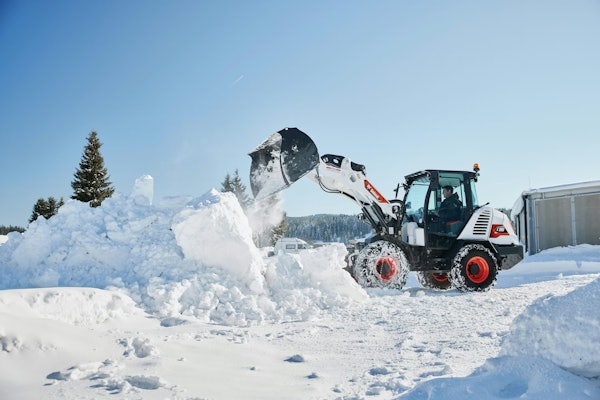 Green building is in, and that includes roads and streetscapes.
Green building is in, and that includes roads and streetscapes.
But unlike building construction, which has the U.S. Building Council’s LEED rating system, the nation’s highway system doesn’t have a green rating system of its own.
Highways, roads, and infrastructure projects are not specifically addressed by LEED standards. They can be designed and built in a sustainable manner, “but there aren’t an equivalent set of standards to LEED,” Nancy Somerville, executive vice president and CEO for the American Society of Landscape Architects (ASLA), tells Better Roads.
LEED, the common term for the Leadership in Energy and Environmental Design Green Building Rating System, was developed by the U.S. Green Building Council in 1998 to provide a set of standards for environmentally sustainable construction.
ASLA has been involved in trying to develop LEED-type standards that would apply to a broad range of design sites, whether it’s a streetscape, a highway corridor — everything from the building on out. In fact, just two months ago, in early November, The Sustainable Sites Initiative — a partnership between ASLA, the Lady Bird Johnson Wildflower Center at The University of Texas at Austin and the United States Botanic Garden — began accepting applications for pilot projects that will test the first national rating system for sustainable landscapes. The application process opened on Nov. 5, 2009, and will close on Feb. 15, 2010, in conjunction with the release of the next report and new rating system, online at www.sustainablesites.org.
Until now, design and construction rating systems included little recognition for benefits of sustainable landscape and site design. Yet landscapes can clean water, reduce pollution and restore habitats, all while providing significant economic benefits to land owners and municipalities.
“Roads are a huge part of our urban fabric…but stormwater runoff from roads is the No. 1 cause of pollution in urban watersheds,” Somerville says. “It’s very significant and hard to deal with because it’s not just like dealing with a factory — a single location. It comes from an entire city.”
That’s why all of the “connective tissue” is key, Somerville points out. Streetscapes can use a system of stormwater planters to manage stormwater runoff. “Roads can be designed so that waste from it is diverted off the road and into the planters,” she says. “By doing that, you’re significantly reducing the amount of stormwater. A lot of this can be done as a retrofit project.”
Without vegetation, a site loses its natural capacity for stormwater management, filtration, and groundwater recharge, according to The Sustainable Sites Initiative (Go to www.sustainablesitesinitiative.org for more information.) Reduced vegetative cover also affects soil health, because vegetation maintains soil structure, contributes to soil organic matter, and prevents erosion. Through evaporation, transpiration, and the uptake and storage of carbon, trees and other vegetation moderate the climate of the world and provide a breathable atmosphere.
Portland, Ore., is one of a growing number of areas that is retrofitting its streetscapes to be more sustainable. Portland has redesigned its streetscapes with stormwater planters.
Houston also has integrated sustainability and stormwater management into its vegetation and erosion control plans along city highways. “Houston has done a good job of how it has dealing with vegetation along areas of its highways,” Somerville says. The area along highways is usually depressed so it collects water. But in Houston, the area along the highway is designed to collect water runoff.
“This keeps stormwater from rushing into the systems, but being used for the vegetative system,” Somerville points out. “The soil does a significant job in filtering the water.” In fact, she says, “it’s doing a lot to actually clean the water.” Vegetating the areas along the roadways and highways also provides air-cooling benefits.
Creating a sustainable site, it can eliminate some of this urban heat while also serving as part of an important ecosystem along highways and streetscapes.
Controls are essential to preventing polluted runoff from roads, highways, and bridges from reaching surface waters, according to the U.S. Environmental Protection Agency (EPA). Erosion during and after construction of roads, highways, and bridges can contribute large amounts of sediment and silt to runoff waters, which can deteriorate water quality and lead to fish kills and other ecological problems, the agency says in its Erosion, Sediment and Runoff Control for Roads and Highways.
“When a project is constructed with heavy equipment, there is the issue of soil compaction,” Somerville notes. “But if you want to leave part of the landscape that is not covered by hardscape, it will only really operate effectively if you don’t have compacted soil. You’ll be able to grow grass on it, but you won’t have the water infiltration and the biological processes. It will act like an impermeable surface.”
That’s why a plan must be created, and to be a successful sustainable site, the plan must be developed in partnership with all the agencies and groups involved in the design and maintenance of the highways and the landscape surrounding it.v
6 Top Tips: Runoff Control for Roads, Highways, and Bridges
Preventing runoff pollution from road, highway, and bridge construction areas requires planning, education, inspection, and maintenance, says the U.S. Environmental Protection Agency’s (EPA) Office of Water. An erosion and sediment control (ESC) plan that incorporates the most appropriate and cost-effective best management practices (BMPs) is essential, the agency notes. Principles of runoff control for roads, highways and bridges from the U.S. EPA’s Office of Water are:
1. Develop a comprehensive erosion and sediment control (ESC) plan prior to earth-moving activities. Write ESC requirements into plans, specifications, and cost estimates for highway and bridge projects. Four key factors affect the potential for soil erosion from a site: soil characteristics, vegetative cover, topography, and climate.
2. Apply ESC practices to prevent excessive onsite damage. Use ESC BMPs to control the flow of runoff water and thereby prevent or lessen soil erosion. Limiting land disturbance and preserving natural vegetation are excellent ESC practices.
3. Apply perimeter control practices to protect the disturbed area from offsite runoff and to prevent sedimentation damage to areas below the construction site. A sediment and runoff barrier surrounding the disturbed area prevents construction site runoff from moving offsite and fouling surface waters downstream.
4. Keep runoff velocities low and retain runoff on the site. The erosive power of runoff increases dramatically as distance and slope increase. BMPs can be used to effectively control runoff velocity and detain it to remove 80 to 90 percent of the sediment from runoff.
5. Stabilize disturbed areas immediately after final grade has been attained. Any exposed soil is subject to erosion from rainfall, wind, and vehicles. BMPs to stabilize soil should be applied as quickly as possible after the land is disturbed. Temporary stabilization practices include seeding, mulching, and erosion control blankets or mats.
6. Develop a schedule and implement a comprehensive inspection and maintenance program. This principle is vital to the success of erosion control. BMPs must receive regular inspection and maintenance to ensure that they are operating effectively and optimally, both during and after construction.
Source: Erosion, Sediment and Runoff Control for Roads and Highways | Polluted Runoff. Additional information is available at www.epa.gov/owow/NPS/education/runoff.html.











